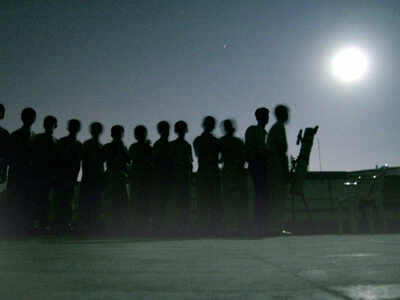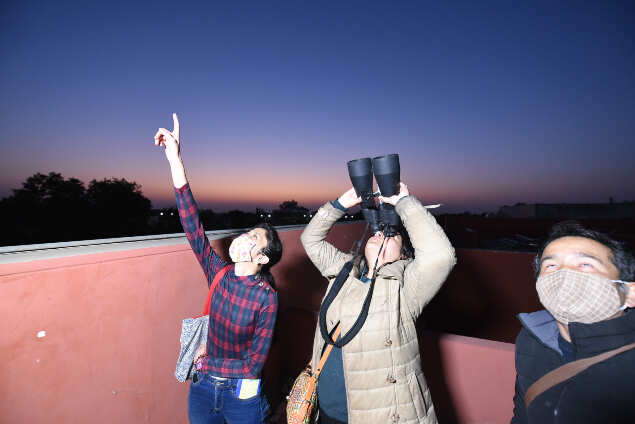Top Searches
- News
- India News
- Mars, Venus set to align today, will be visible with naked eye
Mars, Venus set to align today, will be visible with naked eye

Representative image
NEW DELHI: Skygazers are in for a treat as Mars and Venus— two of the Earth’s closest neighbours — will come closest to each other in the sky on Tuesday. The people would thus have a chance to watch these planets with the naked eye.
This unique phenomenon is part of planetary conjunction as such conjunction takes place when two planets appear to have come closer, while in reality they remain far away.
"Mars and Venus are passing close to each other in the sky and will be only 0.5 deg (as wide as the size of the Moon) on July 13. This is a naked eye event, so go out and see them", Bengaluru-based Indian Institute of Astrophysics (IIA) tweeted recently.

The "celestial kiss" of Mars and Venus will become visible about 45 minutes after sunset under clear weather conditions in the western horizon. The two planets will initially stand 16° above the western horizon and then sink below it 1 hour and 42 minutes after the Sun. Skygazers can spot Venus a bit earlier. Before Tuesday’s celestial event, the Moon passed closest to the two planets on Monday.
After Tuesday’s event, the next Venus-Mars conjunction will occur on February 22, 2024. The last conjunction between the two happened on August 24, 2019 but the planets were only 3° from the Sun and were therefore not visible from the Earth. The most recent visible pairing happened on October 5, 2017. The rare celestial event can be viewed from anywhere in India in clear skies.
Soon after the Mars-Venus conjunction, astronomers may be able to watch through powerful telescopes Pluto on July 17 when the dwarf planet will reach opposition (it will lie opposite to the Sun). It means the Earth will be positioned between Pluto and the Sun, and the dwarf planet makes its closest approach to the Earth (called its perigee), making it appear at its brightest. From Delhi, it is likely to be visible between 9.27 pm and 3.38 am under clear weather conditions on Saturday.
Last year on the night of December 21, skygazers were delighted to watch the great conjunction of bright planets Jupiter and Saturn.
This unique phenomenon is part of planetary conjunction as such conjunction takes place when two planets appear to have come closer, while in reality they remain far away.
"Mars and Venus are passing close to each other in the sky and will be only 0.5 deg (as wide as the size of the Moon) on July 13. This is a naked eye event, so go out and see them", Bengaluru-based Indian Institute of Astrophysics (IIA) tweeted recently.

The "celestial kiss" of Mars and Venus will become visible about 45 minutes after sunset under clear weather conditions in the western horizon. The two planets will initially stand 16° above the western horizon and then sink below it 1 hour and 42 minutes after the Sun. Skygazers can spot Venus a bit earlier. Before Tuesday’s celestial event, the Moon passed closest to the two planets on Monday.
After Tuesday’s event, the next Venus-Mars conjunction will occur on February 22, 2024. The last conjunction between the two happened on August 24, 2019 but the planets were only 3° from the Sun and were therefore not visible from the Earth. The most recent visible pairing happened on October 5, 2017. The rare celestial event can be viewed from anywhere in India in clear skies.
Soon after the Mars-Venus conjunction, astronomers may be able to watch through powerful telescopes Pluto on July 17 when the dwarf planet will reach opposition (it will lie opposite to the Sun). It means the Earth will be positioned between Pluto and the Sun, and the dwarf planet makes its closest approach to the Earth (called its perigee), making it appear at its brightest. From Delhi, it is likely to be visible between 9.27 pm and 3.38 am under clear weather conditions on Saturday.
Last year on the night of December 21, skygazers were delighted to watch the great conjunction of bright planets Jupiter and Saturn.
FacebookTwitterLinkedinEMail
Start a Conversation
end of article
Quick Links
Coronavirus in MumbaiFarm bill 2020Farmers protestCoronavirus in DelhiCoronavirus in BangaloreCoronavirus symptomsCoronavirus in IndiaWest Bengal elections 2021Coronavirus NewsSolar EclipseNPRWhat is NRCCAB BillCAB and NRCAssam election 2021Podcast newsLok SabhaTamil Nadu Election 2021CongressBJP newsKerala Elections 2021Indian ArmyISRO newsSupreme Court

